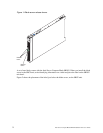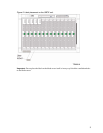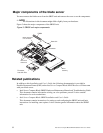5
Intel Server Compute Blade SBX82 features
The design of your blade server takes advantage of advancements in memory management and data
storage. Your blade server uses the following features and technologies:
• Disk drive support
The blade server supports up to two 2.5-inch SCSI disk drives.
• Intel Architecture
Intel architecture technology leverages proven innovative technologies to build powerful,
scalable, reliable Intel-processor-based servers. The technology includes features such as Light
Path Diagnostics, Predictive Failure Analysis (PFA), and Advanced System Management.
• Impressive performance using the latest processor technology
Your blade server supports up to two Intel
®
Xeon
™
processors. The blade server comes with at
least one processor installed; you can install an additional processor to further enhance
performance and symmetric multiprocessing (SMP) capability.
• Integrated network environment support
The blade server comes with two integrated dual Gigabit Ethernet controllers. Each Ethernet
controller has an interface for connecting to 10/100/1000-Mbps networks through an Ethernet-
compatible switch module on the SBCE unit. The blade server automatically selects between
10BASE-T and 100/1000BASE-TX environments. Each controller provides full-duplex (FDX)
capability, which enables simultaneous transmission and reception of data on the Ethernet local
area network (LAN). The controllers support Wake on LAN technology.
• I/O expansion
The blade server comes with two connectors on the system board for an optional expansion card,
such as the Intel
®
Blade Server Fibre Channel Expansion Card or the Intel
®
Blade Server
Ethernet Expansion Card, for adding more network communication capabilities to the blade
server.
• Large system memory
The memory bus in your blade server supports up to 8GB of system memory. The memory
controller provides support for up to four industry-standard 1.8 V, 184-pin, double-data-rate
(DDR2-400), PC3200, registered synchronous dynamic random-access memory (SDRAM) with
error correcting code (ECC) DIMMs.
• Light Path Diagnostics
The Light Path Diagnostics feature provides light-emitting diodes (LEDs) to assist in isolating
problems with the blade server. An LED on the blade server control panel is lit if an unusual
condition or a problem occurs. If this happens, you can look at the LEDs on the system board to
locate the source of the problem.
• PCI Express*
PCI Express* is a fully serial interface that can be used for universal connectivity for use as a
chip-to-chip interconnect, I/O interconnect for adapter cards, and an I/O attachment point to
Gigabit networking devices. PCI Express bridges a PCI Express bus to a PCI-X bus and converts
the transactions on the PCI bus to transactions on the PCI-X bus. Using the expansion card
connector you can add additional LAN interfaces. The expansion card connector supports PCI-
X 133 and bridges PCI Express into PCI-X 133.


















